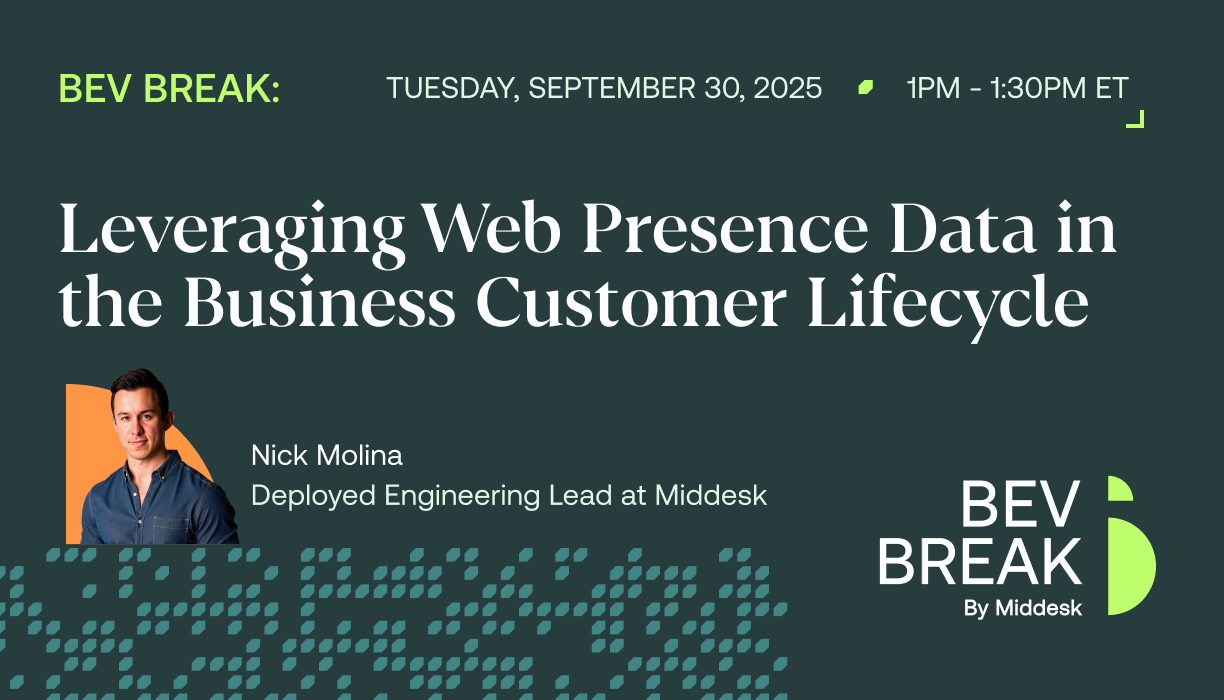September’s BEV Break zoomed in on an often-overlooked source of truth in business verification: web presence data. Middesk’s Engineering Lead, Nick Molina, shared how signals from a company’s online footprint — from domains and SSL certificates to social profiles and third-party listings — can help institutions spot fraud earlier, reduce manual review time, and make smarter decisions across the entire customer lifecycle.
Why web analysis matters now
Fraud is accelerating at an unprecedented rate. One in every 20 verification attempts today is fraudulent — a 21% increase year over year. And in digital-first industries like e-commerce and marketplaces, fraud rates are 18 times higher than the global average.
At the same time, authoritative sources like state registries are being exploited, with bad actors reactivating dormant entities and hijacking legitimate businesses. Relying on government data alone isn’t enough.
That’s where web analysis comes in — offering another layer of visibility to confirm that a business is truly who they claim to be.
📽️ Watch Nick explain why web signals are becoming critical for verification today:
The signals that matter most
Not all online clues are created equal. Nick highlighted the signals that consistently separate legitimate businesses from risky ones: a live, functional website (not a parked domain), details that match across registry and application data, quality markers like valid SSL certificates and reasonable domain age, and contextual cues that reveal whether a business’s site content actually matches its declared industry.
The power lies in how these signals combine. A sleek site with no contact info may raise questions, while an older domain with consistent records can still inspire confidence. Context is everything. And when you connect web signals with authoritative data — what Nick dubbed the “Middesk triangle of verification” — you create a stronger foundation for trust.
📽️ Watch Nick share the most decision-useful signals to track:
From signals to decisions
Web presence data shows its true impact when applied across the lifecycle. Early on, it helps filter out prospects with no real footprint. During onboarding, it can act as a step-up check when registry data conflicts with an application. And over time, ongoing monitoring surfaces new risks when websites suddenly change, disappear, or redirect to unrelated content.
What turns these signals into real value is decisioning. Clean matches should move quickly through approval, mismatches deserve review, and high-risk patterns — like brand-new domains paired with missing contact info — should trigger holds until corroboration comes in. By structuring web analysis this way, institutions can reduce manual review, spot fraud sooner, and keep their compliance programs defensible at scale.
🎬 Watch how Nick explains the workflow — from clean matches to step-up reviews to full declines — and why automation makes it scalable:
Final thoughts
Nick closed with a few quick wins: auto-run web checks for high-risk industries or missing URLs, build simple rules that escalate when key risk signals appear, and monitor for sudden site changes to catch problems early. Small steps like these make web data actionable today while laying the groundwork for smarter automation tomorrow.
Web presence data isn’t a replacement for government records, but it’s the connective tissue that makes business identity sharper in a digital-first world. By layering these signals into existing workflows, financial institutions can reduce friction for good customers, stay ahead of bad actors, and grow with confidence.




